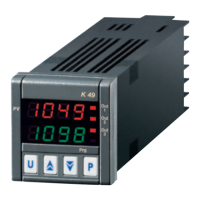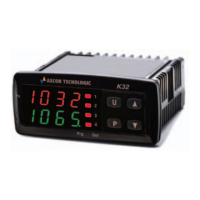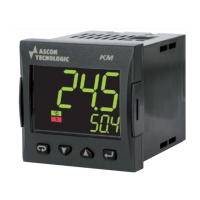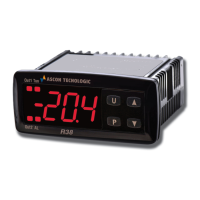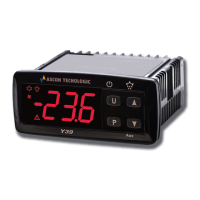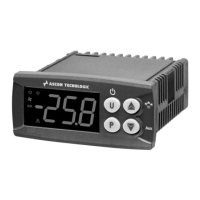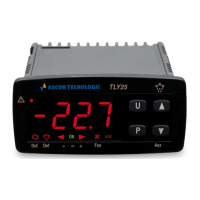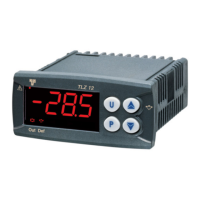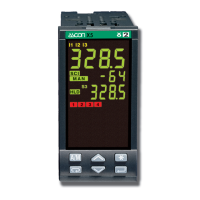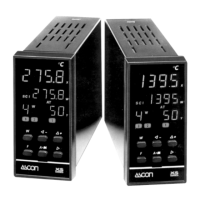Ascon Tecnologic - K Series - ENGINEERING MANUAL - Vr. 9.0 PAG. 6
5.5 Keyboard functions during the
parameter modification
A short pression on the button allows to exit the current
parameter group and select the next one. A long pres-
sion allows to close the configuration parameter proce-
dure (the instrument returns to the “Standard display”).
When the display is showing a group the button allows
to enter the selected group. When the display is showing
a parameter, this button allows to store the selected value
and to go to the next parameter within the same group.
Increases the value of the selected parameter.
Decreases the value of the selected parameter.
+ These buttons allow to return to the previous group.
Proceed as follows:
Push the button and maintaining the pressure push
the button. At this point, release both the buttons.
Note: The group selection is cyclic as well as the selection
of the parameters in a group.
5.6 Factory reset - Default parameters
loading procedure
Sometimes, e.g. when you re-configure an instrument
previously used for other works or from other people or when
you have made too many errors during configuration and
you decided to re-configure the instrument, it is possible to
restore the factory configuration.
This action allows to put the instruent in a defined condition
(the condition it was at first Power ON).
The default data are those typical values loaded in the
instrument before being shipped from factory.
To load the factory default parameter set, proceed as follows:
1. Press the
button for more than 5 seconds;
2. The display shows alternately
PASS and 0;
3. By
and buttons set the value -481;
4. Push
button;
5. The instrument will turn OFF all LEDs for some seconds,
then it will show
dfLt (default) and turns ON all the
LEDs for 2 seconds. At this point the instrument restarts
as for a new Power ON.
The procedure is complete.
Note: The complete list of the default parameter is available
in Appendix A.
5.7 All parameters configuration
In the following pages we will describe all the parameters of
the instrument. However, the instrument will only show the
parameters applicable to its hardware options in accordance
with the specific instrument configuration (i.e. setting AL1t
[Alarm 1 type] equal to nonE [not used], all parameters
related with the alarm 1 will be skipped).
]inP Group - Main and auxiliary input
configuration
[2] SEnS - Input type
Available: Always.
Range: • When the code of the input type is equal to c
(see “How to order” at Chapter 4):
J = TC J (0... 1000°C/32... 1832°F);
crAL = TC K (0... 1370°C/32... 2498°F);
S = TC S (0... 1760°C/32... 3200°F);
r = TC R (0... 1760°C/32... 3200°F);
t = TC T (0... 400°C/32... 752°F);
ir.J = Exergen IRS J (0... 1000°C/32... 1832°F);
ir.cA = Exergen IRS K (0... 1370°C/32... 2498°F);
Pt1 = RTD Pt 100 (-200... 850°C/-328... 1562°F);
0.50 = 0... 50 mV linear;
0.60 = 0... 60 mV linear;
12.60 = 12... 60 mV linear;
• When the code of the input type is equal to e:
J = TC J (0... 1000°C/32... 1832°F);
crAL = TC K (0... 1370°C/32... 2498°F);
S = TC S (0... 1760°C/32... 3200°F);
r = TC R (0... 1760°C/32... 3200°F);
t = TC T (0... 400°C/32... 752°F);
ir.J = Exergen IRS J (0... 1000°C/32... 1832°F);
ir.cA = Exergen IRS K (0... 1370°C/32... 2498°F);
Ptc = PTC KTY81-121 (-55... 150°C/-67... 302°F);
ntc = NTC 103-AT2 (-50... 110°C/-58... 230°F);
0.50 = 0... 50 mV linear;
0.60 = 0... 60 mV linear;
12.60 = 12... 60 mV linear;
• When the code of the input type is equal to i:
0.20 = 0... 20 mA linear;
4.20 = 4... 20 mA linear;
• When the code of the input type is equal to v:
0.1 = 0... 1 V linear;
0.5 = 0... 5 V linear;
1.5 = 1... 5 V linear;
0.10 = 0... 10 V linear;
2.10 = 2... 10 V linear.
Notes: 1. When a TC input is selected and a decimal figure
is programmed (see the next parameter) the max.
displayed value becomes 999.9°C or 999.9°F.
2. Any modification to the
SEnS parameter setting
will force the following changes:
[3] dP = 0;
[129] ES.L = -1999;
[130] ES.H = 9999.
[3] dP - Decimal point position
Available: Always.
Range: When [2] SenS = Linear input: 0... 3.
When [2] SenS is different from linear input: 0 or 1
Note: Any modification to the
dP parameter setting will
produce a change to the parameters related with it
(e.g.: set points, proportional band, etc.).
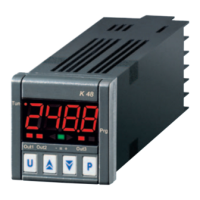
